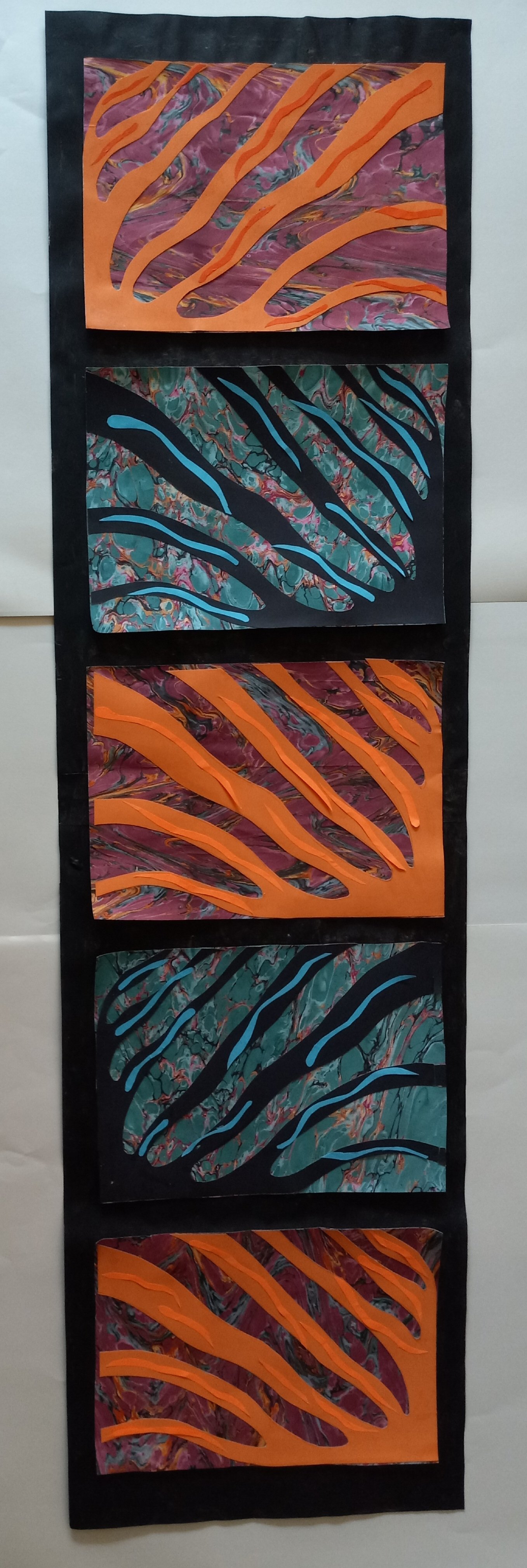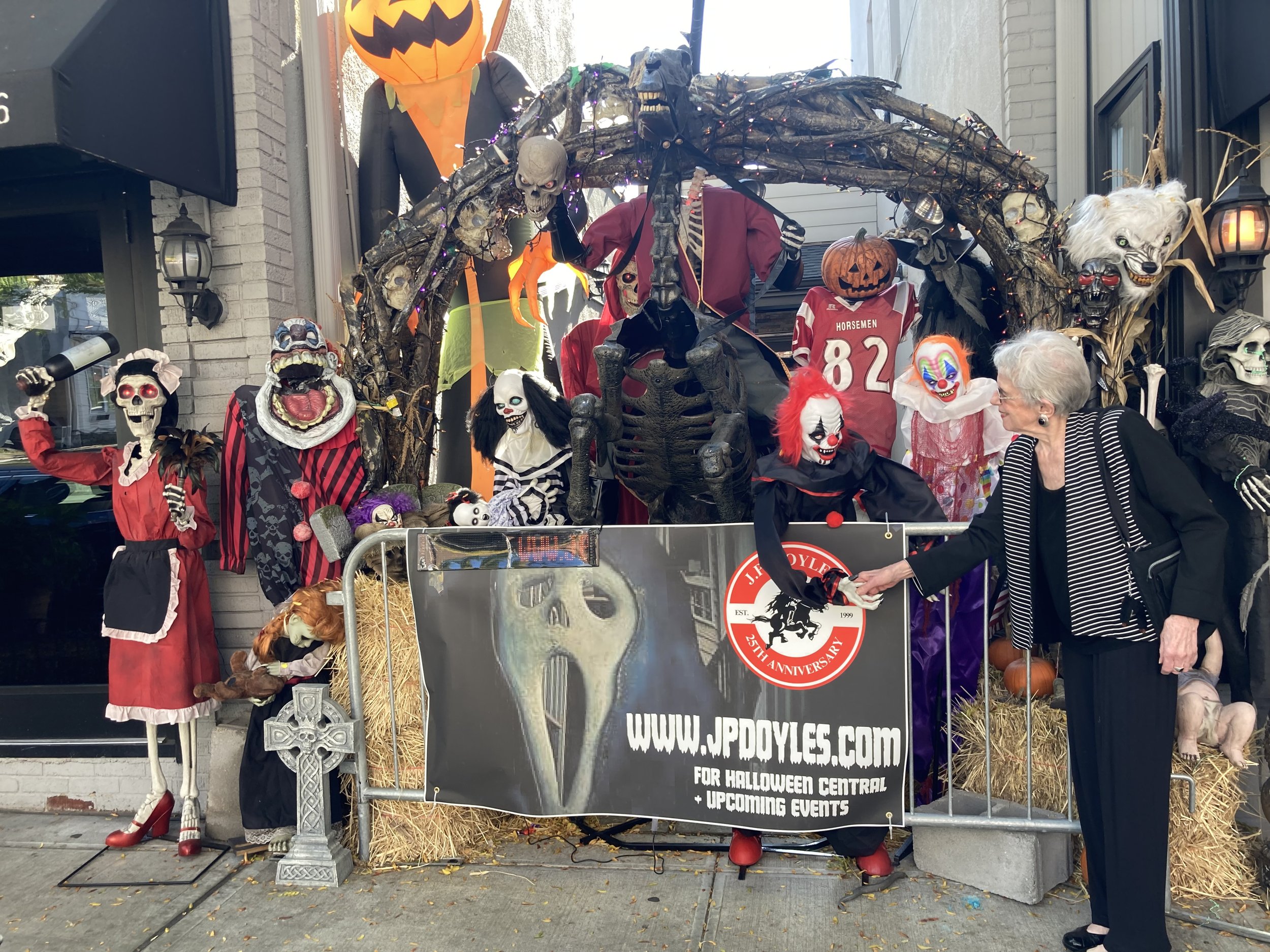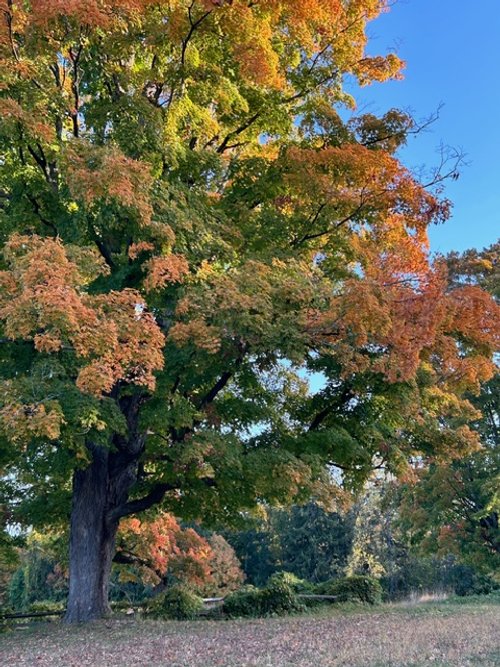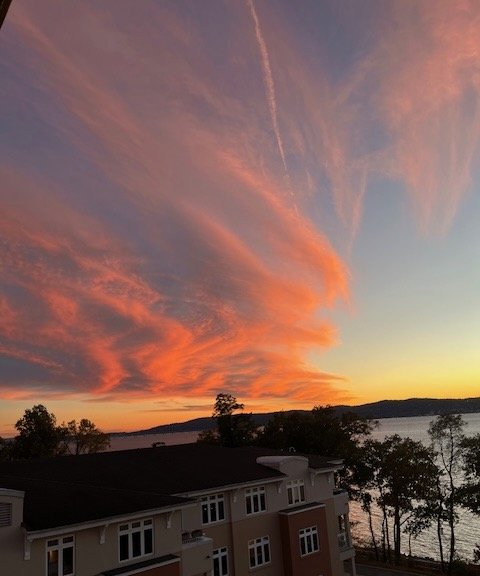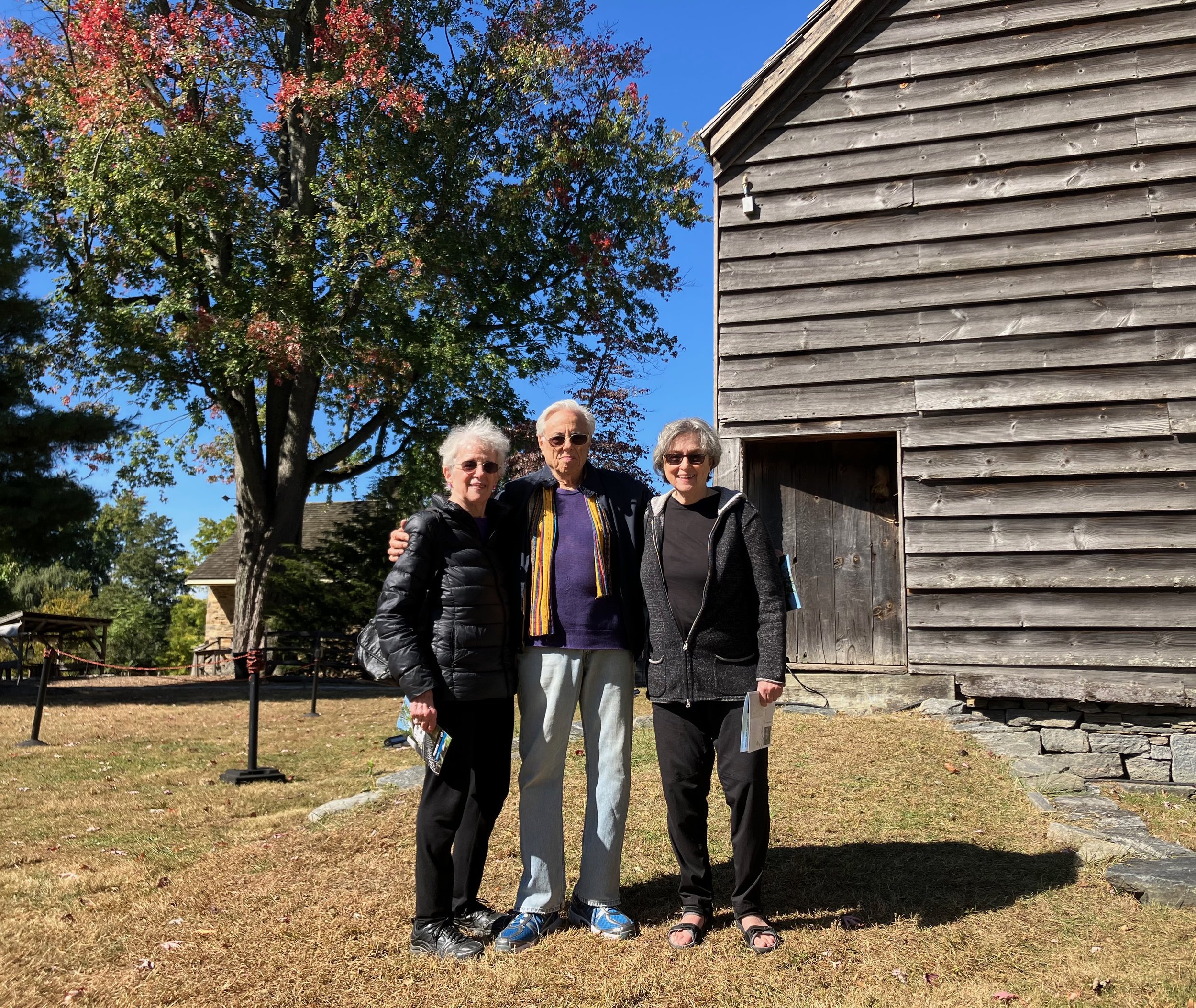Art and photo by Sheila Benedis
In and Around Kendal
Happy October Birthdays!
Photo by Harry Bloomfeld
While Walking in the Park One Day . . .
An October Maple
Photo by Alice Clague
A beautiful fall, only enhanced by two Kendalites and their pups
Photo by Maria Harris
A Kendal photographer at her craft
Photo by Aruna Raghavn
Photo by Joe Bruno
New Garden Plots Are Growing Outside Mary Powell
Photo by Joe Bruno
A View Across the River
Photo by Joe Bruno
And Closer to Home
A Mock on Top
Photo by Naomi Gross
Three chairs and a tree — just waiting . . .
Photo by Naomi Gross
Happy Halloween
The Mahoney-Herrings prepare for the big day
Photo by Linda Mahoney
Out and About
Mimi Tells It Like It Is
On Wednesday, October 23, the Rotary Club of the Tarrytowns had a special speaker at their monthly luncheon meeting at Doyle’s Restaurant: Mimi Abramovitz. Her topic was timely: The Election and Threats to Democracy.” Mimi doesn’t shy away from the scary — whether electoral or Halloween-al, as evidenced by her introduction to the Halloween magic that is Sleepy Hollow.
New York Times Voice of an Expert: Understanding the Present through the Past
When the New York Times needed a learned voice on the question of fascism, it turned to “one of the foremost American experts on fascism and perhaps the greatest living American scholar of mid-20th-century European history.” Who just happens to be a Kendalite: Bob Paxton. The result: a 6-page spread in the October 27th New York Times Magazine Section, which was both fascinating and worrying. Click below to read the article in its entirety.
Election 2024: It's More Than Just Candidates
While the votes you cast for candidates, on page one of your ballot, is always important, don’t forget page 2! Turn your over your ballot and you’ll find 2 ballot proposals. And they are these (as taken from the website of the League of Women Voters of Westchester):
Proposal #1 The NYS Equal Rights Amendment
Description of Proposal: This proposal amends Article 1, Section 11 of the New York Constitution. Section 11 now protects against unequal treatment based on race, color, creed, and religion. The proposal will amend the act to also protect against unequal treatment based on ethnicity, national origin, age, disability, sex, sexual orientation, gender identity, gender expression, pregnancy, and pregnancy outcomes, as well as reproductive healthcare and autonomy. The amendment allows laws to prevent or undo past discrimination.
Question as it Will Appear on Ballot: This proposal would protect against unequal treatment based on ethnicity, national origin, age, disability, and sex, including sexual orientation, gender identity and pregnancy. It also protects against unequal treatment based on reproductive healthcare and autonomy.
A “YES” vote puts these protections in the New York State Constitution.
A “NO” vote leaves these protections out of the State Constitution.
Proposal #2 Westchester County Ballot Proposal: Increase the Term Length for County Legislators from Two to Four Years
Description of Proposal: This proposal amends Chapter 107 of the Laws of Westchester County, known as Westchester County Proposition No. 2024-1, to extend the terms of County Legislators from two to four years, while keeping existing term limits in place. According to the proposers, “[t]his change would allow legislators to concentrate more fully on the needs of their constituents, focus on policy proposals rather than constant campaigning, reduce the cost of administering elections, and align with the standard set by a majority of New York State county legislative bodies, which already have four-year terms.”
Question as it Will Appear on Ballot: Should individuals serving in the position of Westchester County Legislator serve four-year terms instead of two-year terms?
A “YES” vote extends the terms to four years.
A “NO” vote leaves the terms at two years.
Made In NYC: Brands, Trends, and Inventions That Began in the Big Apple
SBARRO
Sbarro is an airport food-hall staple and it seems like there’s one around every touristy corner. (That’s not entirely your imagination: there are 600 locations in 28 countries.) The brand can be traced back to Besonhurst, Brooklyn, where Italian immigrants Gennaro and Carmela Sbarro started up an Italian grocery story in Bensonhurst, Brooklyn. The family held on until 2007, when the chain flipped to private equity investors.
TGI FRIDAY’S
Today TGI Friday’s can be found in 55 countries, with over 600 locations. But location #1 was right here in Manhattan. The address is 1152 First Avenue to be precise, and remnants of that first version can be seen in the current tenant at the space, the bar Baker Street Irregulars. TGI Friday’s started off on March 15, 1965, when Alan Stillman launched the concept in his search for a bar where singles could mingle — a space between male-oriented beer joints and private cocktail parties. He helped launch the singles-bar genre, before selling his stake in the company and moving on to steak (he co-founded the Smith & Wollensky chain).
The Escalator
NYC had the world’s first elevator, and the first escalators as well. Several inventors came up with the concept but didn’t actually produce one. That honor goes to Jesse W. Reno, who put the world’s first escalator into place alongside the Old Iron Pier on Coney Island in 1896. The second installation was also in New York, on the Manhattan side of the Brooklyn Bridge, given a trial run a few months later. Today, it’s estimated 3.5 billion people use an escalator every single day.
Source: “Made In NYC,” by Ethan Wolff, March 2024, City Guide New York
Contributed by Bobbie Roggemann
Good News for Those Driving to Tarrytown
Parking Just Got Easier!
River towns are famous for their lack of parking. These municipalities were built before cars. Once cars came on the scene, they co-existed with streetcars, so a family either didn’t need 1 or only needed 1 automobile. Now-a-days the 2-car family is the norm, and it’s not unusual to find a 3 or 4-car family. But where ya gonna put ‘em all?! The Hudson Independent reported recently on a Tarrytown “innovation” that will help greatly for those Kendalites still driving:
First Public Parking Garage in Tarrytown Unveiled The Hudson Independent October 17, 2024 By Rick Pezzullo
Finding a parking space in downtown Tarrytown just got a little easier with the unveiling Wednesday of a 68-space indoor public garage on the western side of South Washington Street.
“This garage is going to be a game changer,” Tarrytown Mayor Karen Brown said at the ceremonial ribbon cutting ceremony with other village officials and local business leaders. “I’m excited about the positive impact this will have on our downtown businesses.”
The municipal garage was part of a public/private partnership between the village and Wilder Balter Parters (WBP), developers of the 109-unit affordable, multifamily apartments for seniors in the former YMCA building at 62 Main Street.
Village Administrator Richard Slingerland said the parking spaces in the garage will function the same as the lot across the street—open seven days a week for a maximum of six hours at a rate of $1 per hour. (Sunday is free).
Slingerland noted the indoor municipal lot is the first of its kind in the history of Tarryown.
“We’re certainly open to considering similar projects if they were to come up,” he said.
Bjorn Olsson, Executive Director of the historic Tarrytown Music Hall, said the garage will make it easier for residents and visitors to enjoy the shows at his venue and frequent the many restaurants and shops downtown.
“I’m proud of Tarrytown for pulling this together,” he said. “This is an amazing thing.”
You Are Artistically Invited . . .
Oxymorons to Spare
Why do “tug” boats push their barges?
Why do we sing “Take me out to the ball game” when we are already there?
Why are they called “stands” when they are made for sitting?
Why is it called “after dark” when it really is “after light”?
Doesn’t “expecting the unexpected” make the unexpected expected?
Why are a “wise man” and a “wise guy” opposites?
Why do “overlook” and “oversee” mean opposite things?
Contributed by Bobbie Roggemann
I Never Knew That
Where Did Halloween Come From?
It’s not exactly clear what ancient Celts did during Samhain, the pagan holiday we now link with Halloween, but historians have some idea thanks to a surviving bronze calendar. The first written mentions of Samhain appeared in Europe around the first century, marking winter’s swift approach and the start of the Celtic new year. Celebrated on October 31, Samhain was a time when the wall between the spirit plane and the living world was thought to be at its weakest, allowing spirits to cross the boundary with ease. In an effort to curb vandalism and mishaps from angsty ghosts, the Celts hosted welcoming bonfires and left food offerings; eventually, the practice transitioned to dressing as ghouls themselves and traveling door to door in search of refreshments and merriment. Modern Halloween has held tight to many Celtic traditions, like fortune-telling and bobbing for apples, but Roman Christian attempts to squash pagan ceremonies, starting around 600 CE, started the slow transition from religious festival to the spooky secular event.
Colonists in early America brought some Halloween traditions with them (telling ghost stories, pulling pranks, and sharing harvest meals) but strict social and religious rules in Puritan communities scaled back the death-centric influence of early celebrations. Halloween would gain back some of its edge around the mid-1800s when a large influx of Irish immigrants began sharing their holiday traditions passed down from Celtic ancestors, such as carving pumpkins and donning costumes. The Halloween we’re familiar with today slowly spread across the US, and by the 1920s, trick-or-treaters across the country were looking forward to their one night of socially acceptable mischief and candy collecting.
Source: Interestingfacts.com
For Your Funny Bone
Contributed by Gerry Mahoney
In the Light, by Sheila Benedis
In the Light
as a child I have no knowledge of art
i don’t even have a memory of art in grammar school
my parents never even take me to an art museum
I major in math in college
work at inception of computer industry
enjoy the logic of what I am doing
happy I can support myself
otherwise I live in the shadow
elusive veils of mist
I imagine what I want to be
after a friend asks me to take over
teaching a craft art program
I will myself to pay attention to art
I can’t stop learning
I take ownership of life
and my own interpretation of it
the importance of self awareness
creating art becomes the center of my life
I peel away at the surface
find air to breathe
art excavates something wonderful inside myself
I see the light
I inspire joy in others
I live a meaningful life
serendipity
Art by Hart
The kids on Kendal Way went trick-or-treating as a group
After a 15-year yoga/pilates/zumba intensive, Jumbo couldn’t wait to go shopping
Mrs. Klotz could smuggle the twins in anywhere — as long as they pretended to be her earrings
Ceci’s years on the Central Park merry/go-round made her an excellent pole dancer
It was a sure sign of Fall: Ravenel’s five o’clock shadow was coming in at 3 pm
Art and Photos by Jane Hart
In and Around Kendal
Close-Ups
Photos by Mimi Abramovitz
Trivia Night in the Gathering Room
You could feel tensions rising as 5 tables of Kendalites battled for goodies at Trivia Night: the Smarty Pants, Hamsters of the Hudson, the Trivets, the Broncos, and Team A. All teams mustered 8 players each, except the 3 members of Team A, who decided to slug it out with the big guys, anyway. Ellen Ottstadt and Marian Dunn were the MCs, asking questions ranging from softballs like “Who wrote Pride and Prejudice?” to the more challenging “Who was the female rock-and-roll singer who garnered the most Grammys?” Hayley Gibson kept score during the brutal competition. And the winner — by one point— was The Trivets!
The contestants confer . . .
. . . more questions
Score keeper Hayley “Vanna” Gibson
Awaiting the next question . . .
Photos by Harry Bloomfeld
Fall Foliage
Photo by Carolyn Reiss
Contributed by Mimi Abramovitz, looking northward from Alida
Hudson River Sunset
Photo by Jane Hart
Out and About
An Almost Sunset in Boston
Photo by Joe Bruno
Visiting the Past Close By
Judy Levine and Mimi and Bob Abramovitz recently spent a fascinating day at the nearby restoration Philipsburg Manor, viewing the restoration and reenactors of life in Dutch Sleepy Hollow.
A bridge to the past: the manor house and barn
Libations for an autumn day
Photos from Mimi Abramovitz
Reflections in the Water
Contributed by Carolyn Reiss from a walk in the Rockefeller Preserve
Truth is Stranger Than the Comics
While subway traveling to the ballet, Jessica Bacon met a couple of Comicom attendees in full regalia. Uh huh.
Photo by Jessica Baron
Help Is on the Way!
Bring your computer, phone, or tablet and your questions!
Friday, October 25, 10 am in the Gathering Room
by the Computer Committee
With added help by Pace University students!
Made In NYC: Brands, Trends, and Inventions That Began in the Big Apple
The First Movie Theater
Picture originally published as an illustration to “Le Kinétoscope d'Edison” by Gaston Tissandier in La Nature, 1894.
Well, not quite a movie theater as we know them today, but the first commercial motion picture house opened in Manhattan on April 14, 1894. The location was the southeast corner of 27th Street and Broadway (1155 Broadway, which is the site of a modern hotel today). The venue had 10 Kinetoscope screens and you could watch 5 films for a quarter (the Kinetoscope was an early motion picture device, developed at Edison labs and designed for a single viewer to watch the movie through a peephole window.)
The Cure for Tuberculosis
Over a billion people have lost their lives to tuberculosis over the last couple of centuries. Staten Island can claim credit for stemming the tide. In 1951, Dr. Edward H. Robitzek began to give the antibiotic isoniazid to patients at the Sea View Tuberculosis Hospital. The results were miraculous, enough that within a decade the last patient had left (and the bulk of the compound fallen into decay).
Benihana
The international chain Benihana seems like it would have a Japanese origin, but it actually started off in New York City. The first location was on West 56th Street in midtown, where Hiroaki Aoki invested the proceeds from a Harlem ice cream route in 1964. The company now boasts more than 100 locations around the world.
Source: “Made In NYC,” by Ethan Wolff, March 2024, City Guide New York
Contributed by Bobbie Roggemann
Kendal Artist Goes to the Dogs
Jane Hart is known for her portraiture, but her real love and specialty is portraits of beloved pets. Here’s her latest, held by a happy owner.
Oxymorons to Spare . . .
Is it good if a vacuum really sucks?
Why is the third hand on the watch called the second hand?
If a word is misspelled in the dictionary, how would we ever know?
If Webster wrote the first dictionary, where did he find the words?
Why do we say something is out of whack? What is a whack?
Why does “slow down” and “slow up” mean the same thing?
Why does “fat chance” and “slim chance” mean the same thing?
Contributed by Bobbie Roggemann
I Never Knew That . . .
It Can Take 50 Years for a Saguaro Cactus to Grow One Arm
It’s not easy to be a cactus — surviving in a scorching environment with little water is a pretty tough task for most plants. Some cacti, like the saguaro, have adapted by taking their sweet time to grow. In fact, saguaro cacti often reach just 1.5 inches in the first 10 years of their lives. Growing their iconic arms — often featured in old Western films and desert art landscapes — can take 50 years, or even up to 100 years in drought-like conditions.
Many saguaros do not flower until they reach 35 years old. And although they produce some 40 million seeds over their lifetime, odds are that just one of their cacti descendants will survive to adulthood after battling arid conditions, trampling, human interference, and invasive species that threaten their environments. Reaching their maximum size — upwards of 45 feet tall and more than 2 tons in weight — can take 175 to 200 years, close to the end of a saguaro’s lengthy lifespan. But there is perhaps one consolation involved in that long journey: Saguaros are the largest cactus species in the US.
These slow-growing giants are found wild only in the Sonoran Desert, which stretches from southeastern California across southwestern Arizona and into Mexico. Despite their vulnerabilities, saguaro are important plants in the Sonoran ecosystem, providing fruit for birds, nectar for bats and other pollinators, and superb nesting spots for wildlife — which is why these colossal cacti are legally protected native plants in Arizona.
Source: interestingfacts.com
Contributed by Jane Hart

